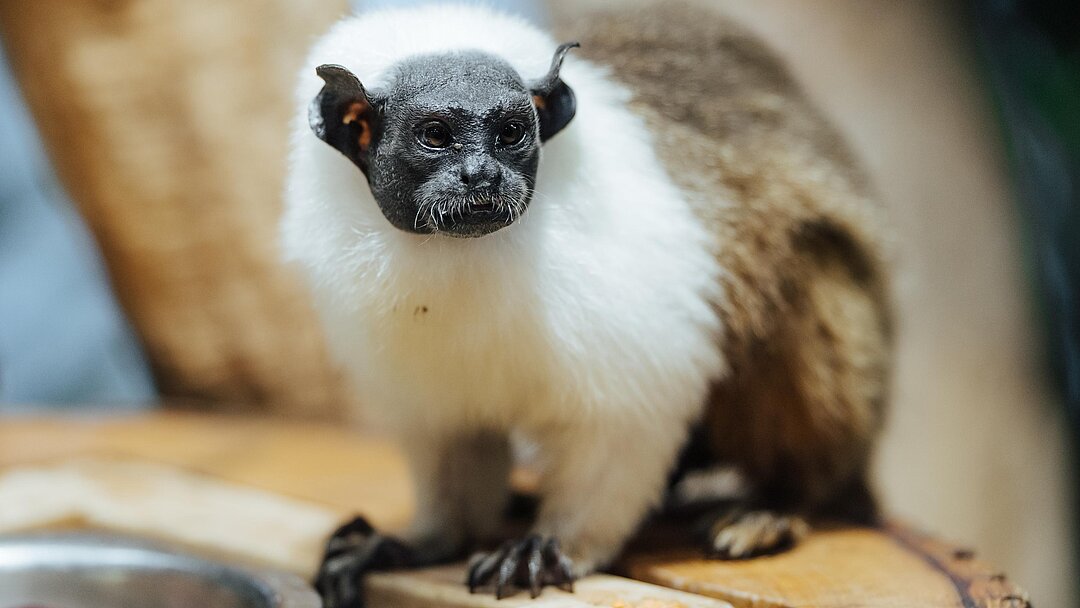
Hellabrunn Zoo is delighted to announce a special addition to its World of Small Monkeys exhibit: the habitat is now home to pied tamarins (Saguinus bicolor) for the first time. These strikingly patterned primates, who moved into the facility a few weeks ago, are characterised by their black hairless faces and snow-white ‘mantles’. They are considered critically endangered in their natural habitat in Brazil.
Striking features – small, agile, unique
Pied tamarins are compact, agile New World monkeys: Their body length can reach around 30 cm, with a slightly longer tail. Adults of both sexes weigh about 500 g. The species is known for its contrasting colours: white fur on the shoulders and upper body, light to dark brown lower body, and a black hairless face with large ruffled ears. Like all members of the Callitrichidae family of New World monkeys, they have claws instead of nails on their hands and feet (except for the big toe), which help them climb and dash through the trees.
Habitat & behaviour – suburban primate with small home range
In the wild, the pied tamarin can only be found in a small area just outside the city of Manaus in Brazil. Its original habitat is the contiguous rainforest of the state of Amazonas, but the species is increasingly being forced to make do with small patches of severely degraded and fragmented forest around the rapidly growing city. Pied tamarins live in groups containing multiple males and females, ranging in size from two to fifteen members. Each group is led by a dominant female, who is the only female allowed to mate. She ensures this by releasing a pheromone that suppresses the estrus cycles of the other females. The alpha female typically gives birth to twins. Infants are primarily cared for by the dad, who only transfers them to the mother at feeding time.
Pied tamarins enjoy a diet of fruits and flowers, as well as sugary gums and saps extracted from trees. During the dry season, when these food sources become more scarce, they hunt small animals such as insects, frogs and lizards, or prey on bird eggs and nestlings. Their preference for fruit helps promote seed dispersal – an important ecological role in the rainforest.
Conservation status – critically endangered
Verena Dietl, mayor and chair of the supervisory board of Hellabrunn Zoo, is thrilled about the new arrivals: “The pied tamarin, the new primate species at the zoo, demonstrates how valuable international cooperation for conservation efforts is and what responsibility we, as the state capital, bear with regard to Hellabrunn. I am proud that Hellabrunn makes such projects possible, thus setting an example for sustainable, global commitment to the care and breeding of endangered primate species.”
“The arrival of the pied tamarins is important for us in many respects: They are fascinating ambassadors of a unique but highly threatened rainforest world – and they allow us to engage visitors about the need to protect these small, often overlooked primates,” said Rasem Baban, zoo director at Hellabrunn. “At the same time, by keeping the adult pair and a young animal, we can strengthen the conservation breeding programme for European zoos.”
Dr Hanspeter Steinmetz, deputy head of zoology at Hellabrunn Zoo, said: “According to the IUCN, the species is classified as Critically Endangered (CR), meaning it is threatened with extinction. The main reasons for this are the ongoing destruction and fragmentation of its habitat to make way for regional infrastructure, and competition with the widespread golden-handed tamarin (Saguinus midas).” The veterinarian added: “Given that the pied tamarin has such a relatively tiny range, even small conservation measures can have a big impact. Hellabrunn Zoo is making an important contribution to education and research by caring for these three animals. Furthermore, we have been granted permission to breed pied tamarins, which is essential for ensuring a healthy safety net population.”
Background information: Since 2009, the Brazilian government has loaned 172 pied tamarins to various institutions around the world for conservation breeding programmes. The goal is to establish a safety net population in zoos, whose offspring will be reintroduced to the region after reforestation efforts. The EAZA Ex-situ Programme (EEP) for the pied tamarin is managed by the Durrell Wildlife Conservation Trust, headquartered at Jersey Zoo in the Channel Islands (English Channel), which strictly controls the selection of participating zoos, husbandry conditions and breeding permits. Individuals kept in ex-situ habitats are considered the property of the Brazilian state.
Hellabrunn Zoo – a forward-looking approach
The pied tamarins can now be seen in the World of Small Monkeys. Animal lovers who would like to support their conservation can do so through our animal adoption programme, or by making a donation. Their new enclosure in the World of Small Monkeys features a variety of climbing structures, perches, platforms and vertical walkways, as well as hidden feeding stations that encourage natural foraging behaviour.
The zoo is also home to another species of tamarin, the critically endangered cotton-top tamarin, who until recently lived in the World of Small Monkeys. This species is currently being kept behind the scenes and will remain part of the Hellabrunn Zoo family. The cotton-top tamarins are expected to be on view again in another part of the zoo that is currently under renovation. We keep all our Hellabrunn fans up to date with the latest news via our social media channels.